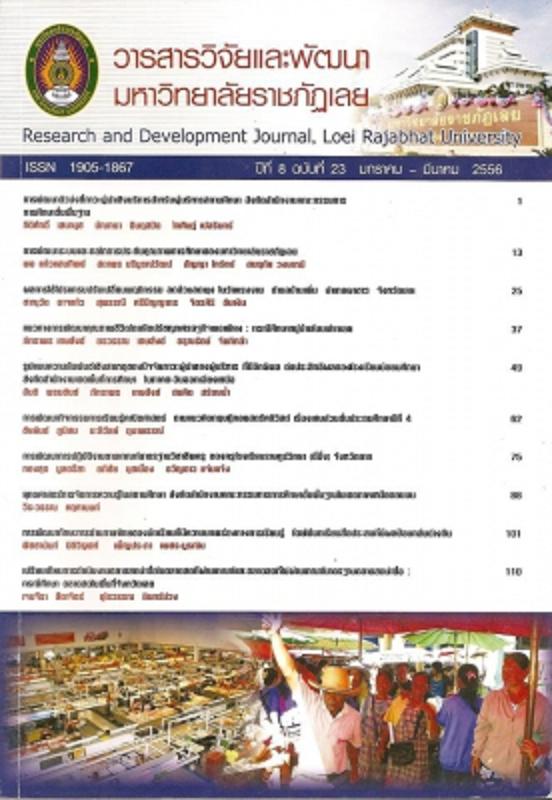การพัฒนาระบบและกลไกการประกันคุณภาพการศึกษาของมหาวิทยาลัยราชภัฏเลย
Keywords:
ระบบและกลไก, การประกันคุณภาพการศึกษา, องค์ประกอบ, ตัวบ่งชี้, system, educational assurance, elements, key performance indicators (kpi)Abstract
บทคัดย่อ
งานวิจัยเรื่องการพัฒนาระบบและกลไกการประกันคุณภาพการศึกษาของมหาวิทยาลัยราชภัฏเลย มีวัตถุประสงค์เพื่อ สำรวจความคิดเห็นของผู้มีส่วนได้ส่วนเสียที่มีต่อระบบการประกันคุณภาพการศึกษาของมหาวิทยาลัย และประเมินผลลัพธ์ของการประกันคุณภาพการศึกษา โดยมีผลจากการวิจัยดังนี้
ผลสำรวจความคิดเห็นของผู้มีส่วนได้ส่วนเสียของมหาวิทยาลัยราชภัฏเลยที่มีต่อระบบการประกันคุณภาพการศึกษาของมหาวิทยาลัย พบว่า อาจารย์ และบุคลากร มีความคิดเห็นต่อการประกันคุณภาพการศึกษาในระดับปานกลาง ( = 3.10, S.D. = 0.95) โดยประเด็นการให้ความสำคัญและมีส่วนร่วมในการประกันคุณภาพการศึกษา มีคะแนนมากที่สุด ( = 3.56, S.D. = 0.95) จากการสอบถามด้านผลลัพธ์ของการกำกับติดตามผลการดำเนินงาน พบว่างานประกันคุณภาพการศึกษามีความถี่ในเก็บเอกสารมากเกินไป มีผลกระทบต่องานประจำเนื่องจากเป็นงานที่นอกเหนืองานที่เคยปฏิบัติ ทัศนคติของบุคลากรส่วนใหญ่พบว่า งานประกันคุณภาพการศึกษา เป็นงานที่ยุ่งยาก วุ่นวาย ไม่มีการเปลี่ยนแปลง หรือพัฒนา อาจารย์ และบุคลากร เสนอแนะให้มีการอบรมการประกันคุณภาพทุกๆ ปี เพื่อจะได้นำไปพัฒนาและเข้าใจรายละเอียดต่างๆ ส่วนนักศึกษามีความคิดเห็นต่อการประกันคุณภาพการศึกษา ในระดับมาก ( = 3.60, S.D. = 0.73) โดยนักศึกษามีความคิดเห็นในด้านอาจารย์มีบุคลิกภาพดี ใช้คำพูด การแต่งกาย และการวางตัวที่เหมาะสมได้คะแนนสูงสุด ( = 3.80, S.D. = 0.65) นักศึกษามีข้อเสนอแนะเพื่อสนับสนุนการดำเนินงานประกันคุณภาพการศึกษามากที่สุด คือ อยากให้มหาวิทยาลัยมีการประชาสัมพันธ์งานด้านต่างๆ สำหรับนักศึกษาให้มีความทั่วถึง และให้มีระบบมากกว่านี้
ผลการประเมินผลลัพธ์ของการประกันคุณภาพโดยการศึกษา เอกสารรายงานประจำปี (Annual Report) ที่เป็นรายงานการประเมินตนเอง (Self Assessment Report : SAR) และรายงานผลการประเมินคุณภาพการศึกษาภายใน ในช่วง 3 ปีย้อนหลัง ตั้งแต่ปีการศึกษา 2549 – 2551 พบว่า สามารถจำแนกเป็นองค์ประกอบคุณภาพทั้งหมด 9 องค์ประกอบ และมีตัวบ่งชี้สำหรับประเมินผลการดำเนินงานในแต่ละองค์ประกอบ 40 ตัวบ่งชี้ จากตัวบ่งชี้ทั้งหมดพบว่ามีตัวบ่งชี้ที่เป็นปัจจัยนำเข้า 6 ตัวบ่งชี้ ตัวบ่งชี้กระบวนการ 21 ตัวบ่งชี้ และเป็นตัวบ่งชี้ผลผลิตหรือผลลัพธ์ 13 ตัวบ่งชี้ จากการประเมินผลลัพธ์จากคะแนนการประเมินในรายองค์ประกอบพบว่า ปีการศึกษา 2550 มีผลคะแนนรวมทุกองค์ประกอบสูงที่สุด ประเมินผลลัพธ์จากคะแนนผลการประเมินในรายตัวบ่งชี้ พบว่า มีตัวบ่งชี้ที่ได้คะแนนเต็ม 3 คะแนน ตลอดทั้ง 3 ปีการศึกษา จำนวน 16 ตัวบ่งชี้ และมีตัวบ่งชี้ที่ได้คะแนนเฉลี่ยที่ต่ำตลอดทั้ง 3 ปีการศึกษา จำนวน 8 ตัวบ่งชี้ ประเมินผลลัพธ์จากการบรรลุเป้าหมายเมื่อเปรียบเทียบกับผลการดำเนินงานพบว่าในปีการศึกษา 2549 มีตัวบ่งชี้ที่บรรลุเป้าหมายทั้งหมด 20 ตัวบ่งชี้ ปีการศึกษา 2550 มีตัวบ่งชี้ที่บรรลุเป้าหมาย 18 ตัวบ่งชี้ และปีการศึกษา 2551 บรรลุเป้าหมาย 22 ตัวบ่งชี้ เมื่อเปรียบเทียบผลการดำเนินงานในปีการศึกษา 2549 – 2551 มีตัวบ่งชี้ที่ผลการดำเนินงานไม่บรรลุเป้าหมายทั้ง 3 ปีการศึกษา จำนวน 8 ตัวบ่งชี้
Abstract
The research on the development of the Educational Assurance system of Loei Rajabhat University had the objective to investigate the opinions of the stakeholders towards the educational assurance system, and the results of the study are as follows;
The result from the investigation of the opinions of the stakeholders toward the educational assurance system of Loei Rajabhat University indicated that lecturers, and officers have the opinions at the average level score of 3.10, and the issues of giving attention and cooperation of the educational assurance are rated maximum score 3.56 scores.
From the survey of the follow-up results of the system, it indicated that the educational assurance system requires the paper works too frequently. Consequently, it affected the routine works of the lecturers and the officers of the University.
The attitude of most officers indicated that the educational assurance system was in confusion and disorder, but has no changes and development. As a result, the lecturers, and the officers suggested that the university should provide the training program on educational assurance for the understanding of the lectures and the officers and for the development of the university every year.
The students’ opinions toward the educational assurance system were at high level (3.60 scores). The students’ attitude indicated that the lecturers have good personality and good manners such as proper speak and dress at 3.80 scores. And the students suggested that the university should publicize the university’s activities and businesses to the students more systematically.
The result on the assessment of educational assurance from the Annual Report which was the Self Assessment Report : SAR, and the report of the internal educational assurance during the past three years (2006-2008) indicated that;
It can be categorized into 9 elements includes 40 key performance indicators : 6 input indicators, 21 process indicators, and 13 output/outcome indicators.
It was found that in 2007, the assessment result was the highest. The key performance indicators’ assessment displayed that, in the past three year: there were 16 key performance indicators rated at full scores, and 8 key performance indicators rated went on at low level.
The results of the assessment comparing to the performance indicated that in 2006 20 key performance indicators achieved the goal; in 2007, 18 key performance indicators achieved the goal; and in 2008, 22 indicators achieved the goal.
Comparing with the results of performance, in the past three year, 8 key performance indicators cannot be achieved.
Downloads
How to Cite
Issue
Section
License
ข้อความที่ปรากฎในวารสารฉบับนี้เป็นความคิดเห็นของผู้เขียนแต่ละท่าน สถาบันวิจัยและพัฒนา มหาวิทยาลัยราชภัฏเลย และกองบรรณาธิการ ไม่จำเป็นต้องเห็นด้วยและไม่มีส่วนรับผิดชอบใดๆ
สถาบันวิจัยและพัฒนา มหาวิทยาลัยราชภัฏเลย ขอให้ผู้อ่านอ้างอิงในกรณีที่ท่านคัดลอกเนื้อหาบทความในวารสารฉบับนี้



